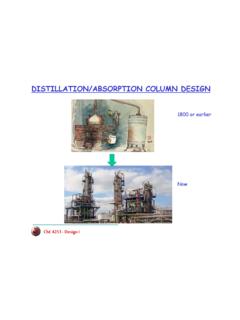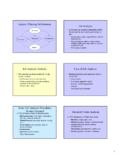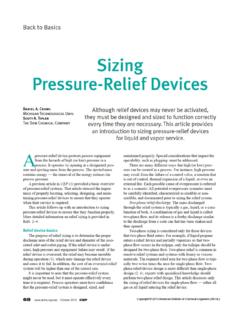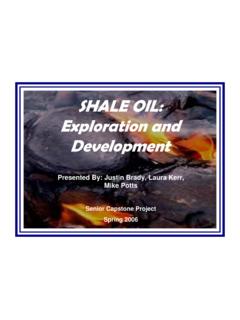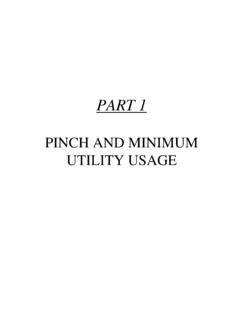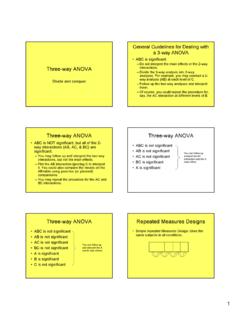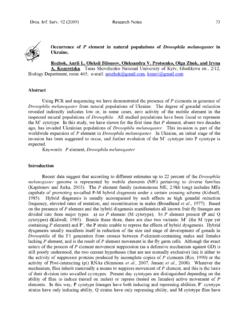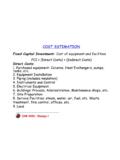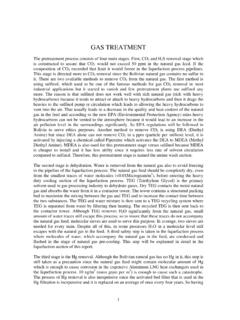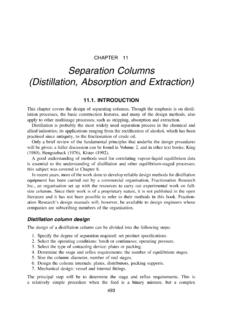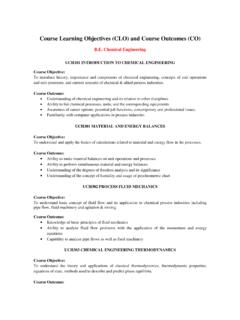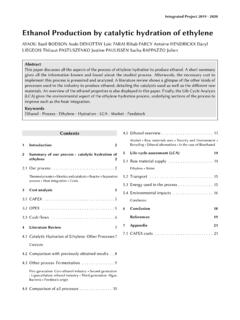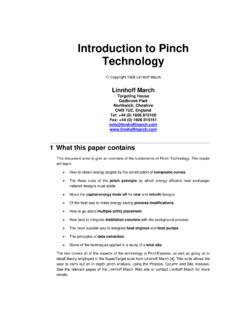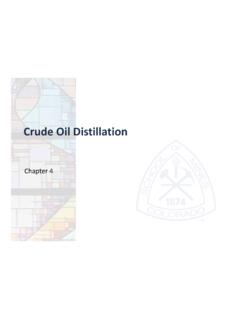Transcription of 99% Oxygen Production with Zeolites and Pressure Swing ...
1 99% Oxygen Production with Zeolites 99% Oxygen Production with Zeolites and Pressure Swing Adsorption: and Pressure Swing Adsorption: Designs and Economic AnalysisDesigns and Economic AnalysisPresentation by:Blake AshcraftJennifer SwentonProject GoalsProject Goals Develop a portable and hospital air Develop a portable and hospital air separation process/device with silver separation process/device with silver Zeolites to produce a continuous flow of Zeolites to produce a continuous flow of 99% oxygen99% Oxygen Recommend the application of the Recommend the application of the process/device in different marketsprocess/device in different markets Determine if process/device will be Determine if process/device will be profitable in those marketsprofitable in those marketsOverviewOverview Market for Purified OxygenMarket for Purified Oxygen Air Separation MethodsAir Separation Methods Adsorbent MaterialsAdsorbent Materials Proposed Use of TechnologyProposed Use of Technology Hospital
2 DesignHospital design Portable DesignPortable design Consumer Utility and PreferenceConsumer Utility and Preference Business PlanBusiness Plan RiskRisk RecommendationsRecommendationsMarket for 99% OxygenMarket for 99% Oxygen Oxygen is the third most widely used Oxygen is the third most widely used chemical in the worldchemical in the world Annual worldwide market of over Annual worldwide market of over $9 $9 billionbillion.. Main applications:Main applications: Medical Oxygen for hospitals and individual Medical Oxygen for hospitals and individual useuse Industrial applications for refineries and Industrial applications for refineries and processing plantsprocessing plantsOxygen in MedicineOxygen in Medicine Inhalation therapy Inhalation therapy During surgery to maintain tissue oxygenation under During surgery to maintain tissue oxygenation under anesthesia anesthesia Resuscitation of patientsResuscitation of patients The treatment of such diseases as chronic obstructive The treatment of such diseases as chronic obstructive pulmonary disease, pneumonia, and pulmonary embolismpulmonary disease, pneumonia.
3 And pulmonary embolism For the newborn experiencing respiratory distress syndromeFor the newborn experiencing respiratory distress syndrome The treatment of respiratory burns or poisoning by carbon The treatment of respiratory burns or poisoning by carbon monoxide and other chemical substances monoxide and other chemical substances Portable Oxygen Portable Oxygen ConcentratorsConcentrators Currently no portable device capable of Currently no portable device capable of producing 99% Oxygen continuouslyproducing 99% Oxygen continuously Portable Oxygen cylinders with 99% Oxygen Portable Oxygen cylinders with 99% Oxygen lasts up to 8 hourslasts up to 8 hours Percentage of individuals suffering from Percentage of individuals suffering from lung diseases such as chronic obstructive lung diseases such as chronic obstructive pulmonary disease (COPD) is increasingpulmonary disease (COPD) is increasing COPD is 4 COPD is 4ththleading cause of death leading cause of death worldwideworldwideHospital UnitHospital Unit Large hospitals spend an estimated Large hospitals spend an estimated $170,000 per a year on Oxygen $170,000 per a year on Oxygen Approximately 350 large hospitals in Approximately 350 large hospitals in United StatesUnited States OnOn--site unit allows for:site unit allows for.
4 Unlimited supply of Oxygenunlimited supply of Oxygen Annual savingsAnnual savingsAir SeparationAir Separation Air is used as feed Air is used as feed stockstock Oxygen is Oxygen is separated based on separated based on physical physical characteristicscharacteristics Must remove Must remove Nitrogen and Argon Nitrogen and Argon for 99% Oxygen for 99% Oxygen puritypurityAir Separation MethodsAir Separation Methods Cryogenic DistillationCryogenic Distillation Membrane SeparationMembrane Separation Pressure Swing Adsorption (PSA) Pressure Swing Adsorption (PSA)Cryogenic SeparationCryogenic SeparationCryogenic SeparationCryogenic Separation Leading process for producing Leading process for producing 99% Oxygen in Oxygen in bulk. Involves liquidifying air and Involves liquidifying air and distilling the liquid air to distilling the liquid air to separate the Oxygen , Nitrogen, separate the Oxygen , Nitrogen, and Argon.
5 Can be sold in a liquid be sold in a liquid L of liquid Oxygen = 860 L of 1 L of liquid Oxygen = 860 L of gaseous Oxygengaseous OxygenCryogenic SeparationCryogenic Separation DrawbacksDrawbacks Process uses large bulky Process uses large bulky equipmentequipment Energy requirements are Energy requirements are substantial unless demand substantial unless demand is more than 60 tons of is more than 60 tons of Oxygen per a day Oxygen per a day Liquid Oxygen evaporates Liquid Oxygen evaporates back into the atmosphere back into the atmosphere over timeover timeMembranesMembranesMembranesMembranes Permeable materials used to selectively separate Permeable materials used to selectively separate Oxygen , Nitrogen, and Argon Oxygen , Nitrogen, and Argon Large and medium scale and medium scale Production .
6 Pressurized air is passed through the membrane Pressurized air is passed through the membrane and is separated by permeability characteristics of and is separated by permeability characteristics of each component in relation to the membrane. each component in relation to the membrane. MembranesMembranesDrawbacksDrawbacks Membranes require a large surface area to achieve high Membranes require a large surface area to achieve high product flow flow rates. Large pressures are typically usedLarge pressures are typically used Safety hazardSafety hazard Large compressorsLarge compressors Oxygen and Argon molecules are similar in size and have Oxygen and Argon molecules are similar in size and have similar permeability properties. similar permeability properties. This results in a selectivity of O2/Ar and a low Oxygen This results in a selectivity of O2/Ar and a low Oxygen Swing AdsorptionPressure Swing AdsorptionPressure Swing AdsorptionPressure Swing Adsorption Uses sorbents ( Zeolites , Uses sorbents ( Zeolites , nanotubes) in two adsorption nanotubes) in two adsorption columns to separate to separate molecules.
7 Two columns allow for the Two columns allow for the process to operate semiprocess to operate semi--continuously. continuously. 4 Process stages4 Process stages Adsorption/ProductionAdsorption/Producti on BlowdownBlowdown/Purge/PurgePressure Swing AdsorptionPressure Swing AdsorptionStage 1 Stage 1 Compressed air is fed Compressed air is fed into the first bed. into the first bed. Nitrogen and argon Nitrogen and argon molecules are trapped, molecules are trapped, while Oxygen is while Oxygen is allowed to flow allowed to flow Swing AdsorptionPressure Swing AdsorptionStage 2 Stage 2 The adsorbent in the The adsorbent in the first bed becomes first bed becomes saturated with nitrogen saturated with nitrogen and argon moleculesand argon molecules The airflow feed is The airflow feed is directed into the directed into the second Swing AdsorptionPressure Swing AdsorptionStage 3 Stage 3 The adsorbent adsorbs The adsorbent adsorbs nitrogen and argon in nitrogen and argon in the second bed.
8 The second bed. The first bed is The first bed is depressurized allowing depressurized allowing argon and nitrogen to argon and nitrogen to be purged out of the be purged out of the system and released to system and released to the atmosphere. the atmosphere. Pressure Swing AdsorptionPressure Swing AdsorptionStage 4 Stage 4 The process starts The process starts over. over. Compressed air is once Compressed air is once again fed into the first again fed into the first bed. bed. The second bed is The second bed is depressurized releasing depressurized releasing argon and nitrogen argon and nitrogen molecules to the molecules to the atmosphere. atmosphere. Adsorbents for PSAA dsorbents for PSA Introduction to Zeolites and Carbon Introduction to Zeolites and Carbon NanotubesNanotubes StructuresStructures ApplicationsApplicationsSilica Gel PretreatmentSilica Gel Pretreatment Pretreatment bed to remove water vapor and impurities Pretreatment bed to remove water vapor and impurities such as carbon dioxide such as carbon dioxide Air at 100% humidity is approximately 3% water vaporAir at 100% humidity is approximately 3% water vapor Water can impair the performance of adsorbents in the Water can impair the performance of adsorbents in the PSA adsorption columns .
9 PSA adsorption columns . Silica gel beds are necessary to remove water vapor Silica gel beds are necessary to remove water vapor from the air. from the air. A heating coil used to evaporate the water from the silica A heating coil used to evaporate the water from the silica gelgelKinetic Separation Kinetic Separation Molecular Sieve Carbon (MSC) Molecular Sieve Carbon (MSC) adsorbents using PSA technologyadsorbents using PSA technology Ideal for separation of Argon and Ideal for separation of Argon and OxygenOxygen MSCsMSCsin kinetic adsorption can adsorb in kinetic adsorption can adsorb Oxygen 30 times faster than ArgonOxygen 30 times faster than Argon Creates a problem in design , requiring two Creates a problem in design , requiring two PSA systems to collect the adsorbed OxygenPSA systems to collect the adsorbed OxygenCarbon NanotubesCarbon Nanotubes Sheets of carbon atoms rolled Sheets of carbon atoms rolled into tubes of varying diametersinto tubes of varying diameters Nanotubes have extraordinary Nanotubes have extraordinary strength strength Potential uses in many industrial Potential uses in many industrial processes, including.
10 Including NanotubesCarbon NanotubesAdvantagesAdvantages Nanotubes have little interaction with nitrogen at Nanotubes have little interaction with nitrogen at high temperatures due to Oxygen s higher packing high temperatures due to Oxygen s higher packing efficiency, smaller diameter, and entropic energiesefficiency, smaller diameter, and entropic energies Research has shown that single walled carbon Research has shown that single walled carbon nanotubes (SWCN) of (SWCN) of have a selectivity of have a selectivity of O2/N2 of 100:1 at 10 of 100:1 at 10 bar. It has been indicated that Argon will have very little It has been indicated that Argon will have very little interaction with nanotubesinteraction with nanotubesCarbon NanotubesCarbon NanotubesDisadvantagesDisadvantages Nanotubes are so efficient the volume of Nanotubes are so efficient the volume of nanotubes required for separation of air nanotubes required for separation of air is much smaller than the volume of feed is much smaller than the volume of feed Nanotubes surface area is not large Nanotubes surface area is not large enough to react with the volume of air enough to react with the volume of air required.
